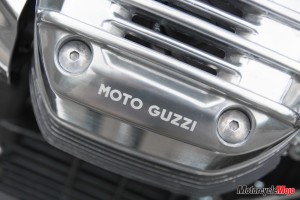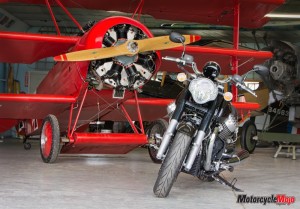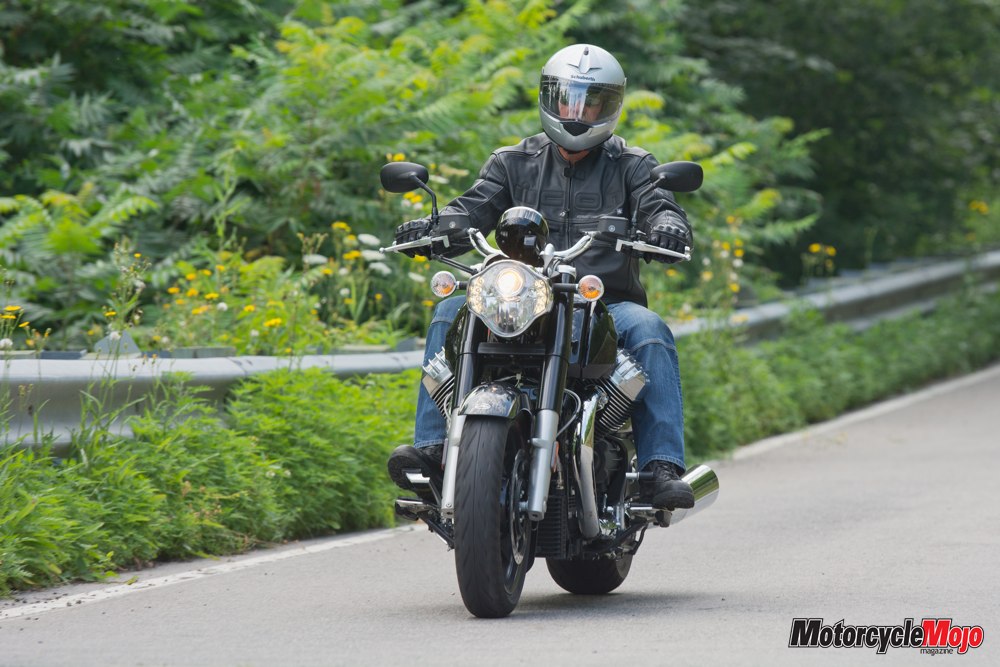It’s big, bold and brash. What’s not to like?
Beginning production in 1921, Moto Guzzi claims to have been continuously operating longer than any other European motorcycle brand. But the brand’s beginnings can be traced even a little earlier than that. Giorgio Parodi, Carlo Guzzi and Giovanni Ravelli, all friends in the Italian Air Corps during the First World War, began talking about producing a new motorcycle company. In 1919, Ravelli died in a plane crash, but the remaining pair continued with their plans to produce motorcycles for the Italian market. The spread-winged eagle logo was designed in memory of their fallen comrade and has graced the brand’s tank ever since the first motorcycle rolled out of the Mandello del Lario factory in northern Italy. The bikes have been handmade in the same plant ever since.
The old saying, “win on Sunday, sell on Monday,” never rang truer, as Moto Guzzi experienced phenomenal success on the racetrack during its early years. Its first win was in the Targa Florio race in 1921. This race paved the way for an amazing 3329 wins by the time Moto Guzzi withdrew from racing in 1957. Some of its most notable accolades included 11 Tourist Trophies and 15 world speed titles.
Moto Guzzi has a faithful following, but the Guzzi isn’t a machine you see on the road every day. This California 1400 Custom might just change all of that. The 2013 California Custom stands out from the crowd and is near impossible to miss. I could swear I gave a few people whiplash when I had the good fortune to borrow one for a week. It drew a lot of attention, and rightly so; it’s big, it’s bold and it’s brash, and such a pleasure to ride.
 I have to be honest – I was intrigued to no end with its styling when I first laid eyes on it, but I wasn’t sure what to expect of its road manners. It didn’t take long to dispel any concerns I had about size, and I soon began to really take a shine to it. The more often I threw my leg over it, the more I liked everything about it.
I have to be honest – I was intrigued to no end with its styling when I first laid eyes on it, but I wasn’t sure what to expect of its road manners. It didn’t take long to dispel any concerns I had about size, and I soon began to really take a shine to it. The more often I threw my leg over it, the more I liked everything about it.
The whole California custom package is larger than life, but the massive oil- and air-cooled engine is by far the main focal point, and as much as you try to look around the bike, your eyes continue to be drawn to the hulking powerplant and transmission. The 1380 cc engine is the largest V-twin ever produced in Europe, and Guzzi makes no attempt to hide it.
 Modern Moto Guzzis are known for their transverse V-twin engine. They look similar to a radial airplane engine with a number of the cylinders lopped off – a fitting tribute to the company’s aviation history. Because of this design, the flywheel runs perpendicular to the frame, giving the engine a sideways torsional twist, in the same way a BMW boxer engine twists sideways when the throttle is blipped. While BMW has all but eliminated that phenomenon in the new GS engine thanks to a lighter crankshaft and smaller clutch assembly, Moto Guzzi keeps it alive and well to the extreme.
Modern Moto Guzzis are known for their transverse V-twin engine. They look similar to a radial airplane engine with a number of the cylinders lopped off – a fitting tribute to the company’s aviation history. Because of this design, the flywheel runs perpendicular to the frame, giving the engine a sideways torsional twist, in the same way a BMW boxer engine twists sideways when the throttle is blipped. While BMW has all but eliminated that phenomenon in the new GS engine thanks to a lighter crankshaft and smaller clutch assembly, Moto Guzzi keeps it alive and well to the extreme.
Each power stroke is felt at idle as the big V-twin shakes violently in a sideways motion (as opposed to an American V-twin, which shakes fore and aft) in its exclusive, elastic-kinematic engine-mounting system. Blipping the throttle rocks both the engine and the bike to the right. But once the 4-valve, 90-degree engine is off idle, all vibration completely disappears and is not felt again throughout the entire rev range. If you like all things mechanical, as I do, the idle shake isn’t annoying, but rather adds even more character to a machine that already oozes personality. The engine sort of rattles to a stop when the ignition is shut off; again, it is not an annoyance, even if it seems a little agricultural, and only adds to the marque’s unique charm. I smiled with approval when I first heard it.
The engine revs with velvet smoothness, and I was surprised when I hit the 7000 rpm redline so quickly. The comfortable seat has a nice pocket to keep you in place and prevent you from sliding back under hard acceleration – maximum torque is experienced at only 2750 rpm – and I soon learned to hold on tight, as a good twist on the throttle launches the bike with authoritative force.
The throttle is controlled using ride-by-wire technology, which opens up a whole new world of electronic wizardry. Functions like traction control and engine management systems can be controlled on the fly. Extremely rare on cruisers are multiple-choice engine management systems, and even more obscure is the opportunity for a language lesson. By pushing the start button when the engine is running, the California Custom offers three engine power curves, displayed on the LCD in Italian. Engine performance varies noticeably between Veloce (Fast), Turismo (Touring) and Pioggia (Rain). The different curves also offer customized traction control for each setting. The traction control, however, can be overridden with three distinct settings.
I would have to say that the shifting on the California is the smoothest I have ever experienced on a big cruiser. So smooth, in fact, that on my first shift I had to check my foot position to make sure I had moved the heel-toe shift lever. All shifts, both up and down, reminded me of a hot knife slicing through butter – completely effortless and quiet. Finding neutral is just as easy, with no bouncing back and forth between first and second.
The hydraulic clutch requires a firm pull on the lever, and the predictable friction point is halfway through the lever’s travel, right where I prefer it. Final shaft drive delivers the power to the 200/60-16 rear tire.
The ride was comfortable, and the front and rear suspension offered adequate travel to float the bike over any road imperfections. The working end of the front fork is shrouded to keep the elements out, but the shrouds also give the front end a presence like the rest of the bike, and each of the rear shocks utilizes a remote reservoir. Rear spring preload and rebound damping is adjustable.
A pair of large rotors, 4-piston Brembo calipers and steel braided brake lines, along with an adjustable front brake lever, combine to slow the bike down fast with a light squeeze that provides good feedback. The rear Brembo brake assembly also supports the bike’s short stopping distance. ABS is standard on the California Custom.
With a ready-to-ride weight of 337 kg (743 lb.), the California is no lightweight, and it seems heavy lifting it off the kickstand, but once balanced on its wheels, it feels lighter, as most of the driveline weight is set low in the frame. Steering is very heavy when the bike is stopped, but most of the weight seems to disappear once underway, and a slight push on the bar end is all that’s needed to turn into a corner. Slow-speed U-turns take a bit of concentration, partly because of the weight, but mainly due to the physical size and long wheelbase of the bike, which is 125 mm longer than the previous California model.
On the highway, the California is a rock that stays planted in its track regardless of which direction the wind is blowing or what is passing in the opposite direction.
Seating position is pure cruiser; feet out front with a slight reach to the handgrips and your derriere cupped in a thin, but wide, comfortable saddle. The wide gas tank splays your legs apart with feet on the footboards, but both the tank and the seat skinny up at their meeting point, making it easy to put feet flat on the ground.
The view from seat presents a simple round gauge, and while it can display a great deal of information, it is one of the less extravagant items on the bike. The outer perimeter is an analog tach, while the LCD centre displays speed, ambient temperature, selected gear, fuel, time and engine mode. Various other information is available by pushing the mode button on the left-hand switchgear.
The company’s attention to detail in so many areas – the big complex headlight, the fuel tank cutouts for the massive cylinder-head covers, passenger pegs neatly tucked away, double-walled exhaust headers and monstrous mufflers, sleek LED taillights, and dozens of other details – make this bike such a standout in a crowd of standards. Heads turn when you ride it, and a crowd gathers when it’s stopped, and for good reason. This Moto Guzzi California 1400 Custom, designed in California, hand-built in Italy, exudes a lovable character and personality that is impossible to dismiss.
Special thanks to the Great War Flying Museum for the photo location.
| The Basics | |
| List Price | $15,490 |
| Warranty | 2 years, unlimited mileage |
| Company URL | motoguzzi-canada.ca |
| The drivetrain | |
| Engine Type | 90° V-twin engine, 4 valves per cylinder, double ignition |
| Displacement | 1380 cc |
| Power (claimed) | 96 hp (71 kW) at 6500 rpm |
| Torque (claimed) | 87 ft-lb (120 N-m) at 2750 rpm |
| Bore and Stroke | 104 × 81.2 mm |
| Compression Ratio | 10.5:1 |
| Fuel Delivery | Multipoint sequential injection, 52 mm throttle body |
| Transmission | 6-speed |
| the essentials | |
| Final Drive Type | Shaft |
| Front Suspension | 46 mm hydraulic telescopic fork |
| Rear Suspension | Double shock absorber with adjustable spring preload and rebound damping |
| Wheel Travel | Front: 120 mm (4.7 in.); Rear: 110 mm (4.3 in.) |
| Brakes | Front: Dual 320 mm stainless-steel floating discs with 4-piston Brembo radial calipers; Rear: 282 mm stainless steel fixed disc with 2-piston Brembo caliper |
| Wheelbase | 1685 mm (66.3 in.) |
| Rake and Trail | 32 degrees/155 mm (6.1 in.) |
| Tires | Front: 130/70 R 18; Rear: 200/60-16 |
| Weight (wet) | 337 kg (743 lb.) |
| Seat Height | 740 mm (29.1 in.) |
| Fuel Capacity | 20.5 litres |
| Fuel Economy (observed) | 6.5 L/100 km |
| Fuel Range (estimated) | 315 km |













































